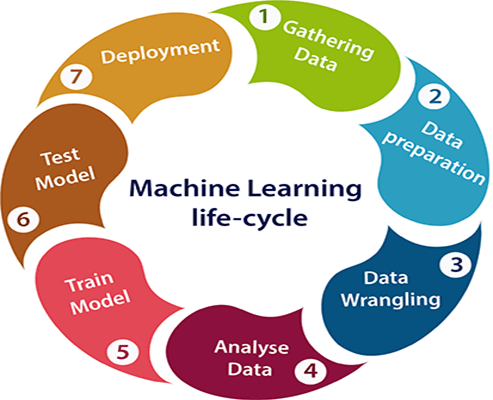Machine learning has given the computer systems the abilities to automatically learn without being explicitly programmed. But how does a machine learning system work? So, it can be described using the life cycle of machine learning. Machine learning life cycle is a cyclic process to build an efficient machine learning project. The main purpose of the life cycle is to find a solution to the problem or project.
Machine learning life cycle involves seven major steps, which are given below:
- Gathering Data
- Data preparation
- Data Wrangling
- Analyse Data
- Train the model
- Test the model
- Deployment
The most important thing in the complete process is to understand the problem and to know the purpose of the problem. Therefore, before starting the life cycle, we need to understand the problem because the good result depends on the better understanding of the problem.
In the complete life cycle process, to solve a problem, we create a machine learning system called "model", and this model is created by providing "training". But to train a model, we need data, hence, life cycle starts by collecting data.
1. Gathering Data:
Data Gathering is the first step of the machine learning life cycle. The goal of this step is to identify and obtain all data-related problems.
In this step, we need to identify the different data sources, as data can be collected from various sources such as files, database, internet, or mobile devices. It is one of the most important steps of the life cycle. The quantity and quality of the collected data will determine the efficiency of the output. The more will be the data, the more accurate will be the prediction.
This step includes the below tasks:
- Identify various data sources
- Collect data
- Integrate the data obtained from different sources
By performing the above task, we get a coherent set of data, also called as a dataset. It will be used in further steps.
2. Data preparation
After collecting the data, we need to prepare it for further steps. Data preparation is a step where we put our data into a suitable place and prepare it to use in our machine learning training.
In this step, first, we put all data together, and then randomize the ordering of data.
This step can be further divided into two processes:
- Data exploration:
It is used to understand the nature of data that we have to work with. We need to understand the characteristics, format, and quality of data.
A better understanding of data leads to an effective outcome. In this, we find Correlations, general trends, and outliers. - Data pre-processing:
Now the next step is preprocessing of data for its analysis.
3. Data Wrangling
Data wrangling is the process of cleaning and converting raw data into a useable format. It is the process of cleaning the data, selecting the variable to use, and transforming the data in a proper format to make it more suitable for analysis in the next step. It is one of the most important steps of the complete process. Cleaning of data is required to address the quality issues.
It is not necessary that data we have collected is always of our use as some of the data may not be useful. In real-world applications, collected data may have various issues, including:
- Missing Values
- Duplicate data
- Invalid data
- Noise
So, we use various filtering techniques to clean the data.
It is mandatory to detect and remove the above issues because it can negatively affect the quality of the outcome.
4. Data Analysis
Now the cleaned and prepared data is passed on to the analysis step. This step involves:
- Selection of analytical techniques
- Building models
- Review the result
The aim of this step is to build a machine learning model to analyze the data using various analytical techniques and review the outcome. It starts with the determination of the type of the problems, where we select the machine learning techniques such asClassification, Regression, Cluster analysis,Association, etc. then build the model using prepared data, and evaluate the model.
Hence, in this step, we take the data and use machine learning algorithms to build the model.
5. Train Model
Now the next step is to train the model, in this step we train our model to improve its performance for better outcome of the problem.
We use datasets to train the model using various machine learning algorithms. Training a model is required so that it can understand the various patterns, rules, and, features.
6. Test Model
Once our machine learning model has been trained on a given dataset, then we test the model. In this step, we check for the accuracy of our model by providing a test dataset to it.
Testing the model determines the percentage accuracy of the model as per the requirement of project or problem.
7. Deployment
The last step of machine learning life cycle is deployment, where we deploy the model in the real-world system.
If the above-prepared model is producing an accurate result as per our requirement with acceptable speed, then we deploy the model in the real system. But before deploying the project, we will check whether it is improving its performance using available data or not. The deployment phase is similar to making the final report for a project.
The next article will learn how to install Anaconda and Python. https://machinelearningteacher.blogspot.com/2020/05/installing-anaconda-and-python.html
The next article will learn how to install Anaconda and Python. https://machinelearningteacher.blogspot.com/2020/05/installing-anaconda-and-python.html

Comments
Post a Comment